Chapter 16 - Frontal Lobes
0.0(0)
Card Sorting
1/122
Earn XP
Description and Tags
Study Analytics
Name | Mastery | Learn | Test | Matching | Spaced |
|---|
No study sessions yet.
123 Terms
1
New cards
what are the symptoms of an infection of LF lobe?
* headaches
* flu like
* disorganized
* showed lil emotion → lack of affect
* flu like
* disorganized
* showed lil emotion → lack of affect
2
New cards
what does the frontal lobe include?
all the tissue anterior to the central sulcus → 30-35% of cortex
3
New cards
what are the four general categories of functionality?
1. primary motor
2. premotor
3. prefrontal
4. anterior cingulate
4
New cards
what does the primary motor cortex (M1) do?
* specific elementary movements → mouth n limbs
* controls movement force and direction
* cells project to subcortical motor structs such as the basal gang and red nucleus and spinal cord
* controls movement force and direction
* cells project to subcortical motor structs such as the basal gang and red nucleus and spinal cord
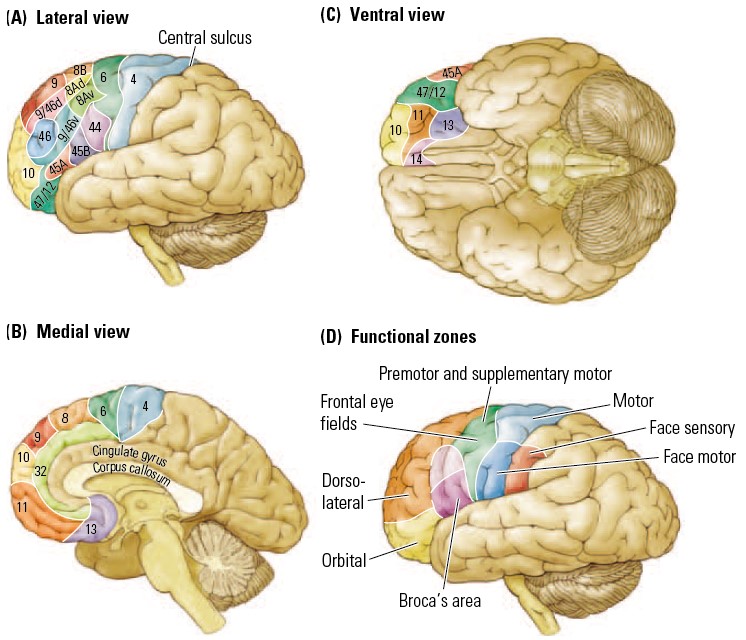
5
New cards
area for primary motor cortex?
area 4
6
New cards
the premotor cortex is anterior to what?
motor cortex
7
New cards
what areas comprises premotor cortex?
* areas
* 6
* 8
* 44 (Broca’s)
* 6
* 8
* 44 (Broca’s)
8
New cards
what does the premotor cortex include?
* dorsal region called supplementary motor cortex
* 3 premotor sections:
1. dorsal (PMd) premotor cortex
2. ventral (PMv) premotor cortex
3. inferior frontal gyrus (Broca’s area)
* 3 premotor sections:
1. dorsal (PMd) premotor cortex
2. ventral (PMv) premotor cortex
3. inferior frontal gyrus (Broca’s area)
9
New cards
when is PMd active?
* for choosing movements form its movement lexicon
10
New cards
what does PMd contain?
* mirror neurons that recog other’s movement and selec similar or diff actions as does Broca’s areas
11
New cards
what can premotor areas do?
* influence movement dirctly, thru corticospinal projections
* or indirectly thru projections to M1
* or indirectly thru projections to M1
12
New cards
what areas constitute the frontal eye field?
areas 8 and 8A
13
New cards
frontal eye fields receive visual input from where?
* posterior parietal region PG
* midbrain superior colliculus
* regions that control eye movements
* and also sends projections to these regions
* midbrain superior colliculus
* regions that control eye movements
* and also sends projections to these regions
14
New cards
where do PMd and PMv receive projections from?
PE and PF
15
New cards
where do all premotor areas receive projections from?
* dorsolateral prefrontal cortex → shows areas implied in controlling limb + eye movements
16
New cards
what does the prefrontal cortex comprise of?
area anterior to the motor, premotor and cingulate cortex
17
New cards
where does prefrontal receive projections from?
mesolimbic dopamine cells in tegmentum → plaus role in regulating how prefrontal neurons react t oto stimuli, including stressful stimuli, and prob contributes to our emotional states
18
New cards
what are the PFC regions?
1. dorsolateral prefrontal cortex (DLPFC)
2. orbitofrontal cortex (OFC)
3. ventromedial prefrontal cortex (VMPFC)
19
New cards
what is the dorsolateral prefrontal cortex (DLPFC)
* areas 9 and 46
* makes reciprocal connections w/ the posterior parietal areas and the STS
* has extensive connections w/ regions to which the posterior parietal cortex also projects
* includes: cingulate cortex, basal gang, sup colliculus
* makes reciprocal connections w/ the posterior parietal areas and the STS
* has extensive connections w/ regions to which the posterior parietal cortex also projects
* includes: cingulate cortex, basal gang, sup colliculus
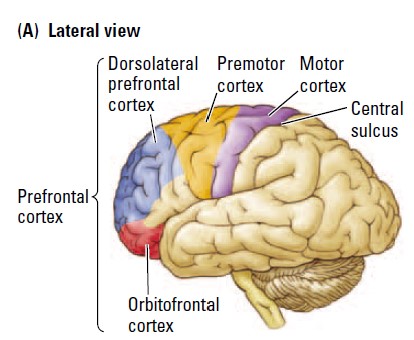
20
New cards
what is the orbitofrontal cortex (OFC)?
* areas 47 and lateral portion of 11,12,13
* gains input from all sensory modalities
* main afferents project from the temporal lobe,
* including auditory regions of sup temp gyrus, visual regions of inferotemporal cortex (area TE), STS, and subcortical amyg
* OFC projects subcortically to amyg and hypothalamus → provide route for influencing the autonomic nervous sys controlling change in blood p, respiration, etc
* gains input from all sensory modalities
* main afferents project from the temporal lobe,
* including auditory regions of sup temp gyrus, visual regions of inferotemporal cortex (area TE), STS, and subcortical amyg
* OFC projects subcortically to amyg and hypothalamus → provide route for influencing the autonomic nervous sys controlling change in blood p, respiration, etc
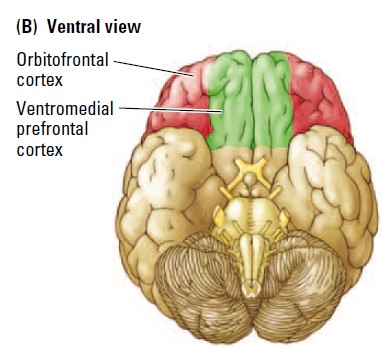
21
New cards
what does S2 comprise of?
somatosensory area 43
22
New cards
what is the ventromedial prefrontal cortex (VMPFC)?
* Area 10, 14, 25, medial parts of areas 11, 12, 3 and anterior part of 32
* receives cortical connections from the DLPFC, posterior cingulate cortex, and medial temporal cortex
* shows connections to amyg, hypothalamus and periaqueductal gray (PAG)
* linked to structs capable of emotional behv bodywide
* receives cortical connections from the DLPFC, posterior cingulate cortex, and medial temporal cortex
* shows connections to amyg, hypothalamus and periaqueductal gray (PAG)
* linked to structs capable of emotional behv bodywide
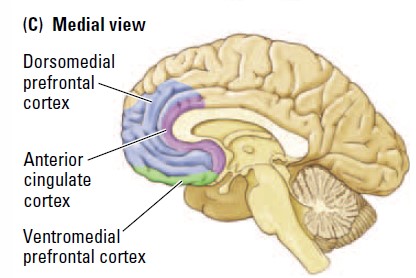
23
New cards
what should the anterior cortex be thought of as?
specialized neocortex
24
New cards
what does the anterior cingulate cortex comprise of and do?
* area 24, and part of 32
* makes extensive bidirectional connections to motor, premotor, preforntal cortex n insula
* makes extensive bidirectional connections to motor, premotor, preforntal cortex n insula
25
New cards
what does the connectome research reveal in terms of frontal lobe?
frontal lob regions are central to many cortical networks
26
New cards
what is the most studied network?
* brain’s **default network** links a set of far-flung brain regions active in participants who r resting rather than engaging in specific cog tasks
* is a misnomer since also active during such directed tasks as thinking abt one’s past (autobiographical memo), thinking abt the future, or when mind wandering
* is a misnomer since also active during such directed tasks as thinking abt one’s past (autobiographical memo), thinking abt the future, or when mind wandering
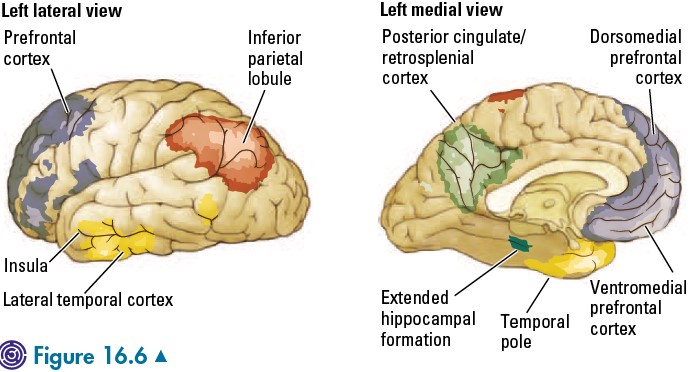
27
New cards
________ ___________ is seen in correlated activity among the anterior cingulate cortex, supp motor cortex, and antererior insular cortex
salience network
28
New cards
when is salience network most active?
* when a behv change is needed and that it operates to modulate other network’s activities
* e.g., if the salience network is not functioning properly, the default network shows excessive activity, leading to lapses in attention.
* e.g., if the salience network is not functioning properly, the default network shows excessive activity, leading to lapses in attention.
29
New cards
prefrontal and ventromedial plays major role in networks involving?
* emotional behv
30
New cards
mood disorders arise when?
abnormal activity in ventromedial and prefrontal
31
New cards
what are the 3 fundamental tasks that challenge frontal-lobe injured patients?
1. planning and selecting from many options
2. ignoring extraneous stimuli and persisting in the task at hand
3. keeping track of the stores to which they have gone and the items that they have alrd purchase
* can be described as the temporal (time) organization of behavior, and this sort of sequential organization is the general function of the frontal lobe
* contains control systems that implement behavioral strategies in response to both internal and external cues → knows as exec func td
32
New cards
premotor regions funcs primarily to selec bhv in response to?
external cues
33
New cards
supplementary motor region makes a greater _________ contribution no no external cue available?
internal
34
New cards
eye movements can be from on the basis of?
either specific target that r visible, or internal cues
35
New cards
difference between area 8 and area 8A?
* 8 → specialized for stimulus-directed movements
* 8A → responsible for internally driven movements
* 8A → responsible for internally driven movements
36
New cards
supplementary motor region plays a special role in?
selecting and directing motor sequences
37
New cards
the premotor cortex is actviated when?
* internal or external cues
* can become associated w/ cues
* e.g., to drive safely, we must learn that red means stop and green means go. When participants are trained on such arbitrary associations in an fMRI paradigm, functional activity in the premotor cortex increases
* can become associated w/ cues
* e.g., to drive safely, we must learn that red means stop and green means go. When participants are trained on such arbitrary associations in an fMRI paradigm, functional activity in the premotor cortex increases
38
New cards
four aspects of movement selection?
1. internal cues
2. external cues
3. context cues
4. autonoetic awareness
39
New cards
what are internal cues?
* The internalized record of what has just taken place is **independent** of existing sensory information and can be called temporal memory, WM, or STM.
* temporal memo refers to a neural record of recent events and their order
* temporal memory for both motor and object information, although the memory will be localized in different places in the prefrontal cortex.
* The dorsolateral areas are especially engaged in selecting behavior based on temporal memory.
* temporal memo refers to a neural record of recent events and their order
* temporal memory for both motor and object information, although the memory will be localized in different places in the prefrontal cortex.
* The dorsolateral areas are especially engaged in selecting behavior based on temporal memory.
40
New cards
what are external cues?
* dependent on enviro cues to determine bhv
* One effect is that people with frontal-lobe injuries have difficulty inhibiting behavior directed to external stimuli
* One type of environmental cue is feedback about the rewarding properties of stimuli.
* One effect is that people with frontal-lobe injuries have difficulty inhibiting behavior directed to external stimuli
* One type of environmental cue is feedback about the rewarding properties of stimuli.
41
New cards
what are context cues?
* bhv context dependent
* depends on social group
* Choosing behaviors in context requires detailed sensory information, which is conveyed to the inferior frontal cortex from the temporal lobe.
* Context also means affective context, and this contribution comes from the amygdala.
* People with orbitofrontal lesions, which are common in closed-head injury, or traumatic brain injury (TBI), have difficulty with context, especially in social situations, and are notorious for making social gaffes.
* depends on social group
* Choosing behaviors in context requires detailed sensory information, which is conveyed to the inferior frontal cortex from the temporal lobe.
* Context also means affective context, and this contribution comes from the amygdala.
* People with orbitofrontal lesions, which are common in closed-head injury, or traumatic brain injury (TBI), have difficulty with context, especially in social situations, and are notorious for making social gaffes.
42
New cards
what is autonoetic awareness?
* bhv controlled by lifetime of experiences and goals
* impairment to autonoetic awareness results in a deficit in bhv self-regulation
* Patients with medial or ventral frontal injury often lose this self-knowledge and struggle in their daily lives.
* impairment to autonoetic awareness results in a deficit in bhv self-regulation
* Patients with medial or ventral frontal injury often lose this self-knowledge and struggle in their daily lives.
43
New cards
what is the general complementary organization of left n right hemis of frontal lobe
* left → associated w/ lang, movements, speech
* right → nonverbal movements like facial expressions
* but lesion studies indicate that both lobes play role in all bhv
* right → nonverbal movements like facial expressions
* but lesion studies indicate that both lobes play role in all bhv
44
New cards
what r people w/ bifrontal lesions impaired in?
* reporting the time of day and in decoding provers
* affects seldom seen in subsequent to unilateral frontal lesions
* affects seldom seen in subsequent to unilateral frontal lesions
45
New cards
what are difference in hemis in terms of memo?
* left → greater role in encoding info into memo
* right → engaged in retrieval more
* right → engaged in retrieval more
46
New cards
what do we need to consider when looking at symptoms for frontal lobe injury?
1. any individual patients is unlikely to show all the symptoms
2. the severity of symptoms will vary w/ lesion location
47
New cards
SNAPSHOT - Heterogeneity of Function in the Orbitofrontal Cortex
* area 13 → connections to hypo n amyg
* area 11 → connections to ventral stream in recog in memo
* diff areas have diff patters of connectivity
* In study participants heard either the sounds of violent car crashes, which the investigators suspected would be perceived as unpleasant, or familiar abstract sounds generated from an electronic keyboard. In the other study, participants were presented with novel, abstract visual designs that they had to either commit to memory or just view. Abstract designs were used to prevent participants from verbalizing the images and thus provoking semantic associations.
* increased activity in area 13 to unpleasant auditory stimuli
* increased activity in 11 when had to learn new visual input
* We might predict that people with damage to area 13 would be less responsive to threatening stimuli, and they are.
* area 11 → connections to ventral stream in recog in memo
* diff areas have diff patters of connectivity
* In study participants heard either the sounds of violent car crashes, which the investigators suspected would be perceived as unpleasant, or familiar abstract sounds generated from an electronic keyboard. In the other study, participants were presented with novel, abstract visual designs that they had to either commit to memory or just view. Abstract designs were used to prevent participants from verbalizing the images and thus provoking semantic associations.
* increased activity in area 13 to unpleasant auditory stimuli
* increased activity in 11 when had to learn new visual input
* We might predict that people with damage to area 13 would be less responsive to threatening stimuli, and they are.
48
New cards
what can frontal lesions lead to ?
impairment on person’s ability to make wide variety of movements, to order movement sequences n speak
49
New cards
what is damage to primary motor cortex (area 4) typic associated w/?
chronic loss of the ability to make fine, independent finger movements, presumably owing to a loss of direct corticospinal projections onto motor neurons
loss of speed strength in both hand and limb movements in contralateral limbs
loss of speed strength in both hand and limb movements in contralateral limbs
50
New cards
removal of the supplementary motor cortex results in what?
transient disruption of nearly all volunt movements (including speech)
51
New cards
why is it that relatively minor symptoms result from rather large supplementary motor lesions?
* both the left n right premotor cortices participate in movement programming
* Each supplementary motor cortex projects bilaterally to the basal ganglia as well
* Although the patients with localized unilateral frontal lobectomies showed mild impairment in copying the arm movements, it was small compared with the performance of patients with left-parietal-lobe lesions. In contrast, patients with both left- and right-frontal lobe damage were dismal at copying a series of facial movements.
* Each supplementary motor cortex projects bilaterally to the basal ganglia as well
* Although the patients with localized unilateral frontal lobectomies showed mild impairment in copying the arm movements, it was small compared with the performance of patients with left-parietal-lobe lesions. In contrast, patients with both left- and right-frontal lobe damage were dismal at copying a series of facial movements.
52
New cards
what difficulties do patient w/ frontal lobe lesions made in facial-movement task?
* more errors of sequence that did control → have difficulty ordering the various components of the sequence into a chain of movements
* frontal lobe may play a special role in controlling the face, perhaps even including the tongue
* frontal lobe may play a special role in controlling the face, perhaps even including the tongue
53
New cards
what did we notice w/ voluntary gaze and eye movements?
* difference in eye-movement patterns in patients w/ large frontal-lobe lesions compared to posterior lesions
* Patients with large frontal-lobe lesions tended to glance over the picture more or less at random
* likely to stem from interrupted activity in the frontal eye fields (
* Patients with large frontal-lobe lesions tended to glance over the picture more or less at random
* likely to stem from interrupted activity in the frontal eye fields (
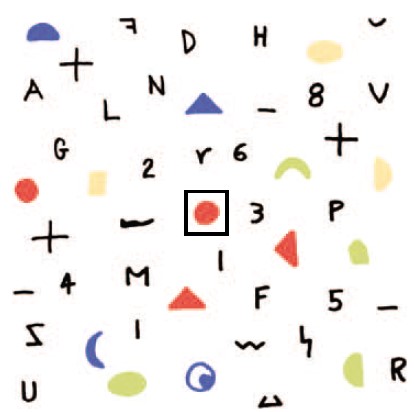
54
New cards
what needs to occur for voluntary movement to take place?
neural signal must produce both the movement and a signal that the movement is going to take place
55
New cards
what is the neurl signal that movement will happen, and the word stays still called?
corollary discharge, or reafference
56
New cards
what occurs in terms of corollary discharge when frontal-lobe lesions occur?
* disturb movement production
* interfere w. the message to the rest of the brain that a movement is taking place
* interfere w. the message to the rest of the brain that a movement is taking place
57
New cards
what are the 2 speech zones?
1. Broca’s area → extension of the lateral premotor area
* selects words on the basis of cues
2. supplementary speech area → extension of supplement motor area 6
* required to retrieve word w/o external cues
58
New cards
what is agrammatism?
* impaired in using verbs n producing appropriate grammar
* occurs when stroke in Broca’s area
* occurs when stroke in Broca’s area
59
New cards
people w/ strokes that include the supp speech area and extend into the adjacent left medial frontal region are often?
mute
60
New cards
can the ability to speak after stroke in supp speech area n adjacent left medial?
* returns a few weeks in unilateral lesion
* NOT in bilateral
* NOT in bilateral
61
New cards
do frontal lesions lead to dramatic decrease in IQ?
no
62
New cards
what is convergent thinking?
* one correct answer to each question
63
New cards
what is divergent thinking?
variety of response to one question
64
New cards
do frontal lobe injuries interfere w/ convergent or divergent thinking?
divergent
65
New cards
what is the loss of spontaneous speech tested by?
Thurstone Word fluency test
66
New cards
lesions where produce loss of spontaneous speech?
* principle locus → left orbitofrontal region
* right also produce marked reduction in verbal fluency
* right also produce marked reduction in verbal fluency
67
New cards
what occurs when suffer from a large astrocytoma to the right frontal lobe?
1. low output
2. rule breaking
3. shaky script
4. perseveration
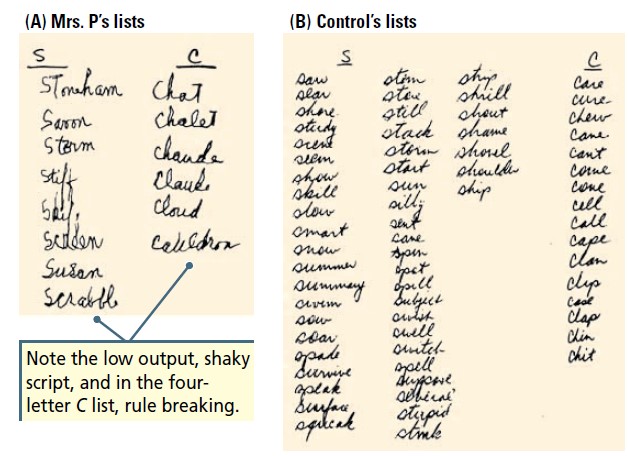
68
New cards
lesions to which frontal lobe produce large decrease in num of diff drawings produced?
right
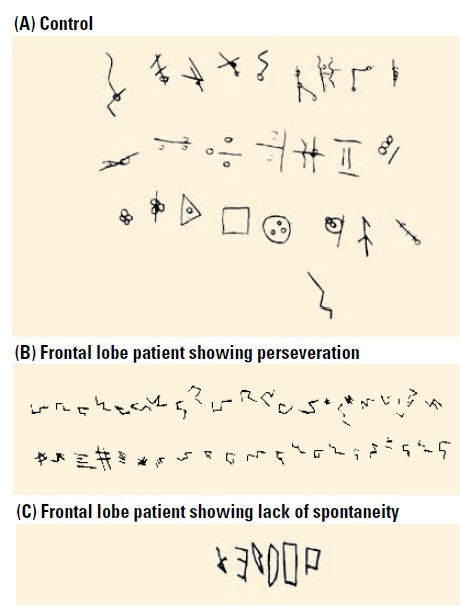
69
New cards
other than reduced spontaneity in speech n doodle, what other aspect affected?
* bhv
* less facial movements
* left-frontal damage → barely spoke
* right-frontal → spoke excessively
* less facial movements
* left-frontal damage → barely spoke
* right-frontal → spoke excessively
70
New cards
characterizes of small frontal-lobe patients?
* lethargic or lazy
* often hard to get out of bed, get dressed, initiate daily activities
* often hard to get out of bed, get dressed, initiate daily activities
71
New cards
can patients w/ frontal lobe lesion dev novel cog plans or strategies for prob solving?
no
72
New cards
what is the most commonly observed trait in frontal-lobe patients?
* difficulty in using enviro cues to regulate or change bhv
* demonstrated in Wisconsin card task n Stroop
* demonstrated in Wisconsin card task n Stroop
73
New cards
what kind of bhv do frontal lobe patient engage in?
* risk taking
* greater risk in patients who also had temporal-lobe damage
* greater risk in patients who also had temporal-lobe damage
74
New cards
what are findings found in fMRI about gambling?
* higher activation in the controls’ OFC and amyg during ambiguous risk-task
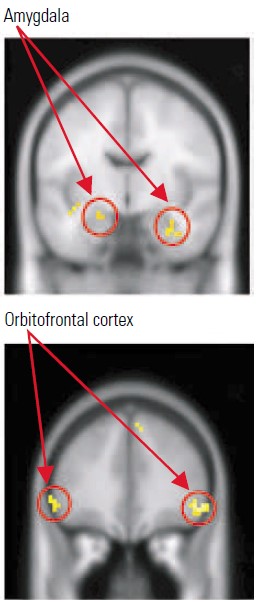
75
New cards
how is self-regulation affected when frontal-lobe damage?
* there is a deficit in regulating bhv in unstruct situations, in part cuz of loss of autonetic awareness
76
New cards
what are patients w/ large frontal-lobe lesions, unable to do?
* regulate bhv in response to external stimuli → learn from experience
* unable to make associations → prob in learning to select, from a set of competing responses
* unable to make associations → prob in learning to select, from a set of competing responses
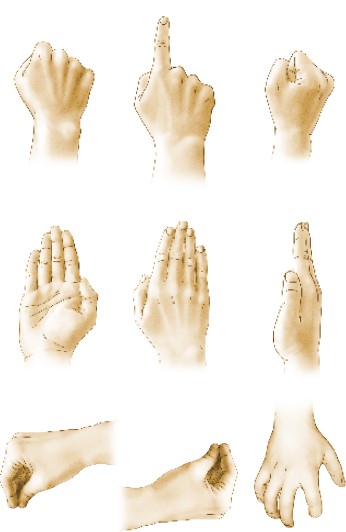
77
New cards
frontal-lobe lesions are impaired in a delayed - _________ ______?
delayed - response test
78
New cards
unilateral lesions in the principle sulcus impaired the monkey’s to do what?
to rmb the location of the target in a restricted region of the contralateral visual field → interpreted this result as showing that the principal sulcus contains a mechanism for guiding spatial responses on the basis of stored information.
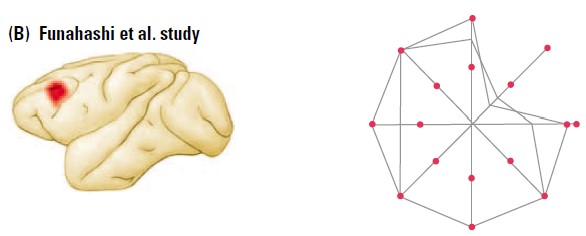
79
New cards
monkeys w/ lesion of area 1 and 32 are impair in what task?
identifying obj saw earlier → result as showing that this frontal area participates in short-term storage of object information.

80
New cards
lesion in area 46 in monkey lead to marked impairments in what task?
strategy in getting food reward. they would return to same door

81
New cards
what does area 46 likely take part in?
providing an internal representation of spatial information
82
New cards
what does the dorsomedial region likely take part in ?
play a similar role with object information.
83
New cards
what does the DLPCF cells appear to integrate?
sound and colour across time
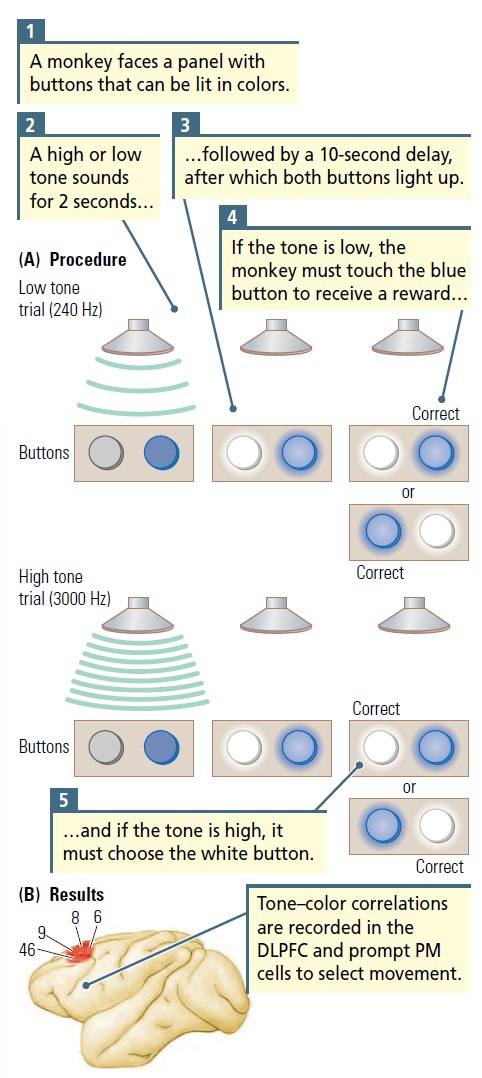
84
New cards
how do frontal lobe patients perform on recency memo test?
* normal on the recog trial
* impaired in judging the relative recency of 2 previously seen items
* relative asymmetry in this regard:
* right lobe appears to be more important for non-verbal, pictorial, recency memo
* left lobe appears to be more important for verbal
* temporal-lobe patients show the opp
* impaired in judging the relative recency of 2 previously seen items
* relative asymmetry in this regard:
* right lobe appears to be more important for non-verbal, pictorial, recency memo
* left lobe appears to be more important for verbal
* temporal-lobe patients show the opp
85
New cards
how did left-frontal lobe lesions patients perform on card task that points to new item?
* associated w/ impaired performance of both verbal and nonverbal versions of the tasks
* right frontal-lobe lesions were associated w/ poor performance on the nonverbal test
* right frontal-lobe lesions were associated w/ poor performance on the nonverbal test
86
New cards
what does the self-ordering task demand?
* self-ordered task demands an accurate memory as well as an organized strategy
* frontal lobe patients did not report using strategy, if did was ill-defined
* frontal lobe patients did not report using strategy, if did was ill-defined
87
New cards
how does frontal lobe lesion affect sex and social behv ?
* impairs
* e.g., Phineas Gage → injury affected left frontal lobe from the orbital region upward into the precentral region
* e.g., Phineas Gage → injury affected left frontal lobe from the orbital region upward into the precentral region
88
New cards
which area of damage is associated with more dramatic changes in personality, orbitofrontal regions or dorsolateral legions?
orbitodfrontal
89
New cards
pseudodepression appear most likely to follow lesions of the?
left frontal lobe
90
New cards
pseudopsychopathic bhv seems likely to follow lesions of the?
right frontal lobe
91
New cards
how do lesions affect sex bhv?
* alter libido
* orbitofrontal lesions → abnormal sex bhv (like masturbation in public) by reducing inhibition
* dorsolateral lesions → reduce interest in sex bhv
* orbitofrontal lesions → abnormal sex bhv (like masturbation in public) by reducing inhibition
* dorsolateral lesions → reduce interest in sex bhv
92
New cards
how do lesions affect social bhv?
* monkeys fall to the bottom of the group hierarchy and eventually die
* humans lack understanding facial expressions
* orbitofrontal lesion
* humans lack understanding facial expressions
* orbitofrontal lesion
93
New cards
results from blood-flow and lesions studies suggest what about the DLPFC?
frontal lobe participates in selecting among diff visual locations
94
New cards
what are the two test batteries that have been designed to measure executive func?
1. EXIT-25
2. Frontal Assessment Battery
95
New cards
are terms exec func and frontal func synonymous?
no
96
New cards
Neuropsychological test for frontal lobe damage
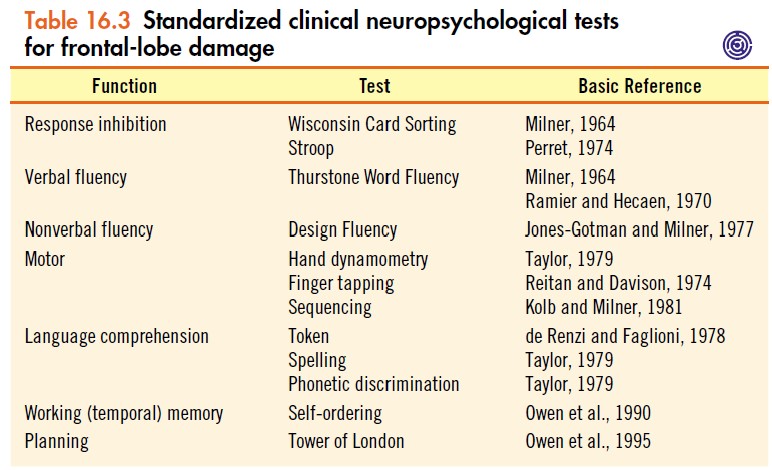
97
New cards
what is Wisconsin Card Sorting test useful for?
* assessing dorsolateral prefrontal cortex func
98
New cards
what is Thurstone word-fluency test useful for?
* identify patients w/ left hemis dorsomedial lesions above the anterior cingulate regions
99
New cards
what is Gotman-Milner Design-Fluency test useful for?
appears most sensitive to right frontal injury
100
New cards
what is Tower of Hanoi and Tower of London test useful for?
* Damage to either the left or the right prefrontal cortex produces impairments on these tasks.